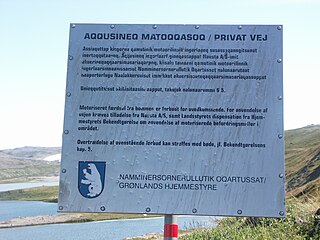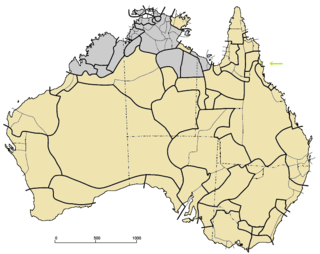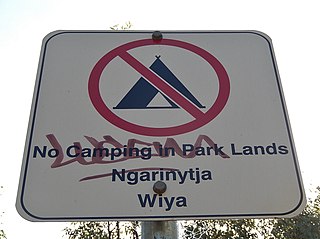In grammar, the dative case is a grammatical case used in some languages to indicate the recipient or beneficiary of an action, as in "Maria Jacobo potum dedit", Latin for "Maria gave Jacob a drink". In this example, the dative marks what would be considered the indirect object of a verb in English.

Wichita is an extinct Caddoan language once spoken in Oklahoma by the Wichita and Affiliated Tribes. The last fluent heritage speaker, Doris Lamar-McLemore, died in 2016, although in 2007 there were three first-language speakers alive. This has rendered Wichita functionally extinct; however, the tribe offers classes to revitalize the language and works in partnership with the Wichita Documentation Project of the University of Colorado, Boulder.

Greenlandic is an Eskimo–Aleut language with about 56,000 speakers, mostly Greenlandic Inuit in Greenland. It is closely related to the Inuit languages in Canada such as Inuktitut. It is the most widely spoken Eskimo–Aleut language.

Alyutor or Alutor is a language of Russia that belongs to the Chukotkan branch of the Chukotko-Kamchatkan languages.

Yidiny is a nearly extinct Australian Aboriginal language, spoken by the Yidinji people of north-east Queensland. Its traditional language region is within the local government areas of Cairns Region and Tablelands Region, in such localities as Cairns, Gordonvale, and the Mulgrave River, and the southern part of the Atherton Tableland including Atherton and Kairi.
Nyangumarta, also written Njaŋumada, Njangamada, Njanjamarta and other variants, is a language spoken by the Nyangumarta people and other Aboriginal Australians in the region of Western Australia to the south and east of Lake Waukarlykarly, including Eighty Mile Beach, and part of the Great Sandy Desert inland to near Telfer. As of 2016 there were an estimated 211 speakers of Nyangumarta, down from a 1975 estimate of 1000.
Personal pronouns are pronouns that are associated primarily with a particular grammatical person – first person, second person, or third person. Personal pronouns may also take different forms depending on number, grammatical or natural gender, case, and formality. The term "personal" is used here purely to signify the grammatical sense; personal pronouns are not limited to people and can also refer to animals and objects.

Pitjantjatjara is a dialect of the Western Desert language traditionally spoken by the Pitjantjatjara people of Central Australia. It is mutually intelligible with other varieties of the Western Desert language, and is particularly closely related to the Yankunytjatjara dialect. The names for the two groups are based on their respective words for 'come/go.'
Tsez, also known as Dido, is a Northeast Caucasian language with about 15,000 speakers spoken by the Tsez, a Muslim people in the mountainous Tsunta District of southwestern Dagestan in Russia. The name is said to derive from the Tsez word for "eagle", but this is most likely a folk etymology. The name Dido is derived from the Georgian word დიდი, meaning "big".
Symmetrical voice, also known as Austronesian alignment, the Philippine-type voice system or the Austronesian focus system, is a typologically unusual kind of morphosyntactic alignment in which "one argument can be marked as having a special relationship to the verb". This special relationship manifests itself as a voice affix on the verb that corresponds to the syntactic role of a noun within the clause, that is either marked for a particular grammatical case or is found in a privileged structural position within the clause or both.
Central Alaskan Yupik, or Yupʼik is one of the languages of the Yupik family, in turn a member of the Eskimo–Aleut language group, spoken in western and southwestern Alaska. Both in ethnic population and in number of speakers, the Central Alaskan Yupik people form the largest group among Alaska Natives. As of 2010 Yupʼik was, after Navajo, the second most spoken aboriginal language in the United States. Yupʼik should not be confused with the related language Central Siberian Yupik spoken in Chukotka and St. Lawrence Island, nor Naukan Yupik likewise spoken in Chukotka.

The Nias language is an Austronesian language spoken on Nias Island and the Batu Islands off the west coast of Sumatra in Indonesia. It is known as Li Niha by its native speakers. It belongs to the Northwest Sumatra–Barrier Islands subgroup which also includes Mentawai and the Batak languages. It had about 770,000 speakers in 2000. There are three main dialects: northern, central and southern. It is an open-syllable language, which means there are no syllable-final consonants.
Ramarama, also known as Karo, is a Tupian language of Brazil.
The Kwaio language, or Koio, is spoken in the centre of Malaita Island in the Solomon Islands. It is spoken by about 13,000 people.
A secundative language is a language in which the recipients of ditransitive verbs are treated like the patients (targets) of monotransitive verbs, and the themes get distinct marking. Secundative languages contrast with indirective languages, where the recipient is treated in a special way.
Amonap, also known as Apalakiri, is a Cariban language spoken by the Kuikuro and Kalapalo peoples of Brazil, and formerly by the Matipu. It is spoken in seven villages along the Culuene River in the Xingu Indigenous Park of Mato Grosso.
Djinang is an Australian Aboriginal language, one of the family of Yolŋu languages which are spoken in the north-east Arnhem Land region of the Northern Territory.
Djaru (Tjaru) is a Pama–Nyungan language spoken in the south-eastern Kimberley region of Western Australia. As with most Pama-Nyungan languages, Djaru includes single, dual and plural pronoun numbers. Djaru also includes sign-language elements in its lexicon. Nouns in Djaru do not include gender classes, and apart from inflections, words are formed through roots, compounding or reduplication. Word order in Djaru is relatively free and has the ability to split up noun phrases. The Djaru language has a relatively small number of verbs, as compared to most languages, and thus utilizes a system of 'preverbs' and complex verbs to compensate. Djaru also has an avoidance language. Avoidance languages, sometimes known as 'mother-in-law languages', are special registers within a language that are spoken between certain family members – such registers are common throughout native Australian languages. The population of Djaru speakers has greatly diminished since the late 19th century when white settlers entered the Djaru region and massacred its inhabitants. The Djaru people have since adopted certain aspects of western living and have moved away from the daily practice of certain traditional ways of living. As a result, the Djaru language faces the combined pressures of a decrease in speaker population, an increased reliance of English among its speakers, as well as a white Australian government that has traditionally stood against the use or education of any original Australian languages.
The grammar of the Klingon language was created by Marc Okrand for the Star Trek franchise. He first described it in his book The Klingon Dictionary. It is a nominative–accusative, primarily suffixing agglutinative language, and has an object–verb–subject word order. The Klingon language has a number of unusual grammatical features, as it was designed to sound and seem alien, but it has an extremely regular morphology.
In linguistic typology, nominative–absolutive alignment is a type of morphosyntactic alignment in which the sole argument of an intransitive verb shares some coding properties with the agent argument of a transitive verb and other coding properties with the patient argument of a transitive verb. It is typically observed in a subset of the clause types of a given language.





